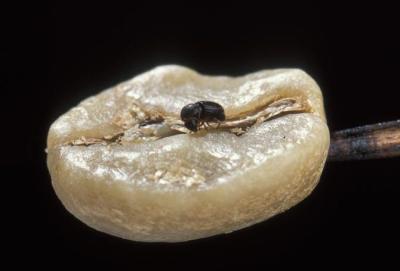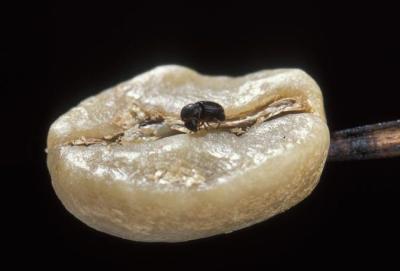

Coffee berry borer (Hypothenemus hampei)
It is the most serious pest of coffee in many of the major coffee-producing countries. Crop losses caused by this pest can be severe, ranging from 50 to 100% of berries attacked if the pest is not controlled. The adult is a tiny (about 1.5 to 2.5 mm long), cylindrical blackish beetle. The females (1.4 to 1.6 mm) penetrate into mature green or red berries, usually from the tip and lay eggs within the beans. Female beetles fly from tree to tree to lay eggs. Once the eggs hatch, the larvae feed on the beans, rendering them unsuitable for commerce or greatly lowering their quality. The white, legless grubs have a brown head. They feed by tunnelling in the tissues of the beans destroying them. Pupation takes place in the berry. Symptoms of attack are one or more small round holes near the apex of large green or ripe berries. The damaged beans, which have a distinct blue-green staining contain up to 20 grubs. Female beetles also attack young berries.
Coffee berry borer damage predisposes the coffee bean to fungal infection and hence contamination with mycotoxins (food poison). Reasons for the infestation with coffee berry borer can be: the plantation is at a too low altitude, too much shade or that there are abandoned or infested plantations nearby. Infestations are carried over between peaks of fruiting by breeding in over-ripe berries left on the tree or fallen to the ground.
- Biological control methods include using parasitoids such as Heterospilus coffeicola, attacking grubs or Prorops nasuta, attacking grubs and pupae. These parasitoids were introduced in Kenya and Tanzania.
- The fungus Beauveria bassiana is found naturally wherever the borer is present. In humid climates infection may reach more than 50%, and is probably the most significant natural control agent of the coffee berry borer. This fungus is used, alone or in combination with neem products, in several countries in South America for control of this pest. The fungus is easy to produce at a commercial scale, but it is difficult to apply (it must infect the adult borer before it bores into the berries), and its effectiveness is affected by the weather. For instance, in Colombia, where this fungus is widely used, much B.bassiana is being produced on farms and by small enterprises using simple technology. This fungus is also produced at industrial-scale by private companies (Smith and Bellotti, 1996; Depieri et al, 2005).
- Proper and timely pruning accompanied by desuckering.
- Field hygiene: A complete harvest and collection of all affected coffee berries on trees as well as dropped berries on the ground; destroy infested berries by burning, deep burying or rapid drying on trays.
- Reduce shade on coffee. Heavy shade and/or inadequately pruned coffee cause unfavourable conditions for the natural enemies of the berry borer.
- Pick berries at least fortnightly during fruiting peaks and at least monthly during other times.
- Sacks or sheets should be spread on the ground to prevent berries from being lost in the mulch.
